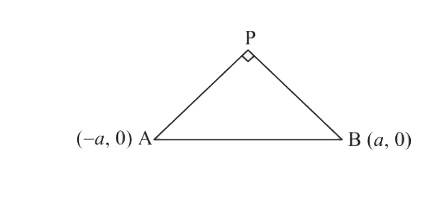A (a,0) , B (-a,0) are two points . If a point P moves such that ∠PAB−∠PBA=π/2 then find the locus of P.
The correct Answer is:a2
To find the locus of point P such that the difference between angles ∠PAB and ∠PBA is π2, we can follow these steps:
1. Identify Points A and B:
Let point A be A(a,0) and point B be B(−a,0).
2. Define Point P:
Let point P have coordinates P(x,y).
3. Calculate Angles:
We need to express tan(∠PAB) and tan(∠PBA):
- For ∠PAB:
tan(∠PAB)=yx−a
- For ∠PBA:
tan(∠PBA)=yx+a
4. Set Up the Equation:
According to the problem, we have:
∠PAB−∠PBA=π2
This implies:
tan(∠PAB−∠PBA)=tan(π2)
Since tan(π2) is undefined, we can use the formula for the tangent of the difference of two angles:
tan(∠PAB−∠PBA)=tan(∠PAB)−tan(∠PBA)1+tan(∠PAB)tan(∠PBA)
Setting this equal to infinity means the denominator must be zero:
1+tan(∠PAB)tan(∠PBA)=0
5. Substitute the Tangents:
Substituting the expressions for tan(∠PAB) and tan(∠PBA):
1+(yx−a)(yx+a)=0
6. Simplify the Equation:
This leads to:
1+y2(x−a)(x+a)=0
Rearranging gives:
y2x2−a2=−1
Multiplying through by (x2−a2) gives:
y2=−(x2−a2)
This simplifies to:
x2+y2=a2
7. Conclusion:
The locus of point P is a circle with center at the origin (0,0) and radius a.
Final Result:
The locus of point P is given by the equation:
x2+y2=a2
Let point A be A(a,0) and point B be B(−a,0).
Let point P have coordinates P(x,y).
We need to express tan(∠PAB) and tan(∠PBA):
- For ∠PAB:
tan(∠PAB)=yx−a
- For ∠PBA:
tan(∠PBA)=yx+a
According to the problem, we have:
∠PAB−∠PBA=π2
This implies:
tan(∠PAB−∠PBA)=tan(π2)
Since tan(π2) is undefined, we can use the formula for the tangent of the difference of two angles:
tan(∠PAB−∠PBA)=tan(∠PAB)−tan(∠PBA)1+tan(∠PAB)tan(∠PBA)
Setting this equal to infinity means the denominator must be zero:
1+tan(∠PAB)tan(∠PBA)=0
Substituting the expressions for tan(∠PAB) and tan(∠PBA):
1+(yx−a)(yx+a)=0
This leads to:
1+y2(x−a)(x+a)=0
Rearranging gives:
y2x2−a2=−1
Multiplying through by (x2−a2) gives:
y2=−(x2−a2)
This simplifies to:
x2+y2=a2
The locus of point P is a circle with center at the origin (0,0) and radius a.
The locus of point P is given by the equation:
x2+y2=a2
Similar Questions
A(a,0) , B(-a,0) are two point . If a point P moves such that ∠PAB−∠PBA=2α then find the locus of P .
View SolutionA (c,0) and B (-c,0) are two points . If P is a point such that PA + PB = 2a where 0<c<a, then find the locus of P.
View SolutionA(1,1) , B (-2,3) are two points . If a point P forms a triangle of are 2 square units with A, B then find the locus of P.
View SolutionA(5,3) B (3,-2) are two points . If a point P forms a triangle of area 9 square units with A,B then find the locus of P.
View SolutionA(2, 0) and B(4, 0) are two given points. A point P moves so that P A 2 + P B 2 = 10 . Find the locus of P.
View SolutionA(2,3) B (-3,4)are two points P moves such that the area of ΔPAB is 8.5 square units, then find the locus of P
View SolutionA(2, 0) and B(4, 0) are two given points. A point P moves so that PA2+PB2=10. Find the locus of P.
View SolutionA and B are two fixed points. The locus of a point P such that ∠APB is a right angle, is:
 View Solution
View SolutionA(2,3),B(1,5),C(−1,2) are the three points . If P is a point such that PA2+PB2=2PC2, then find locus of P.
View SolutionA and B are two fixed points. Draw the locus of a point P such that angle APB=90∘.
View Solution

